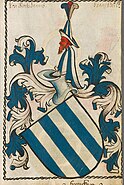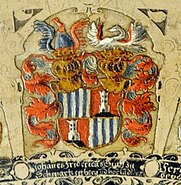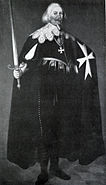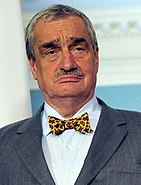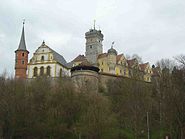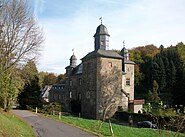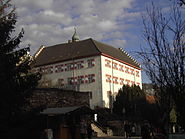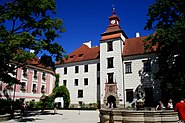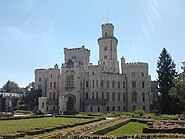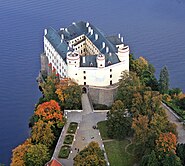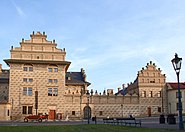| (Princely) County of Schwarzenberg (Gefürstete) Grafschaft Schwarzenberg | |||||
| State of the Holy Roman Empire | |||||
| |||||
|
Coat of arms | |||||
| Capital | Schwarzenberg Castle, Scheinfeld; Český Krumlov (de facto since 1670s) | ||||
| Government | Principality | ||||
| Historical era | Late Middle Ages Early Modern Era | ||||
| - | Acquired by the lords of Seinsheim | 1405 – 1421 | |||
| - | Imperial immediacy | 1429 | |||
| - | Raised to Imperial County |
1599 | |||
| - | Raised to Princely County |
14 July 1670 | |||
| - | Raised to Princely Landgraviate |
1671 | |||
| - | German Mediatisation | 1806 | |||
Schwarzenberg (Czech: ze Švarcenberka) is the name of a Bohemian and Franconian aristocratic family. The Schwarzenbergs were prominent members of the Bohemian nobility and achieved the rank of Princes of the Holy Roman Empire. The family traces its roots to the lords of Seinsheim during the Middle Ages.[1]
The current head of the family is Karl VII of Schwarzenberg, the 12th Prince of Schwarzenberg. He is a Czech politician who served as Minister of Foreign Affairs of the Czech Republic.
History[]
The family stems from the lords of Seinsheim, who had established themselves in Franconia during the Middle Ages.[2] A branch of the Seinsheim family (the non-Schwarzenberg portion died out in 1958) was created when Erkinger of Seinsheim acquired the Franconian territory of Schwarzenberg and the castle of Schwarzenberg in Scheinfeld during the early part of the 15th century. He was then granted the title of Freiherr (Baron) of Schwarzenberg in 1429. At that time, the family also possessed some fiefdoms in Bohemia.
In 1599, the Schwarzenbergs were elevated to Imperial Counts, and the family was later raised to princely status in 1670.[3] The House of Schwarzenberg acquired extensive land holdings in Bohemia in 1661 through a marriage alliance with the House of Eggenberg. In the 1670s, the Schwarzenbergs established their primary seat in Bohemia and, until 1918, their main residence was in Český Krumlov, Bohemia (now in the Czech Republic).
At the beginning of the 19th century, the House of Schwarzenberg was divided into two princely-titled lines (majorats).[4] The senior branch died out in the male line in 1979 upon the death of Joseph III of Schwarzenberg, who was the 11th Prince of Schwarzenberg. The cadet branch was established by Karl Philipp, Prince of Schwarzenberg, at Orlík, Murau and Vienna, and this branch continues to the present day.
The two branches have now been re-united under the current head of the family, Karl VII of Schwarzenberg, who is the 12th Prince of Schwarzenberg. He is a Czech politician and served as Minister of Foreign Affairs of the Czech Republic.
Coat of arms[]
The ancestral arms of the lords of Seinsheim consisted of vertical stripes in silver and blue.[5]
The family became Freiherren (Barons) of Schwarzenberg in 1429, and a silver tower on a black hill was added to their coat of arms to represent Schwarzenberg.[6]
In 1599, Adolf von Schwarzenberg became an Imperial Count, and he added a quarter showing the head of a Turk being pecked by a raven. This was to commemorate the conquest on 19 March 1598 of a Turkish-held fortress in Hungary that was known in German as Raab ('Raven').[7][8][9]
In 1670, the Schwarzenbergs were raised to princely status. Their coat of arms was subsequently augmented, with quarters added for the domains of Sulz, Brandis (canting arms: a brand) and the Landgraviate of Klettgau.[10][11]
Notable family members[]
The House of Schwarzenberg produced many military commanders, politicians, church dignitaries (including a Cardinal), innovators and patrons of the arts.[12] They were related to a number of European aristocratic families, notably the Lobkowicz (Czech: Lobkovicové) family. Some of the most noteworthy members of the Schwarzenberg family are:
- Johann of Schwarzenberg (1463–1528), a judge in Bamberg and friend of Martin Luther
- Adam, Count of Schwarzenberg (1583–1641), an advisor of George William, Elector of Brandenburg
- Georg Ludwig, Count of Schwarzenberg (1586–1646), an Austrian statesman during the Thirty Years War
- Karl Philipp, Prince of Schwarzenberg (1771–1820), an Austrian field marshal during the Napoleonic Wars
- Prince Felix of Schwarzenberg (1800–1852), a Minister-President of the Austrian Empire
- Prince Edmund of Schwarzenberg (1803–1873), an Austrian field marshal
- Friedrich Johannes of Schwarzenberg (1809–1885), a Cardinal and Archbishop of Salzburg, then Archbishop of Prague
- Karel Schwarzenberg (born 1937), a Czech politician, former Minister of Foreign Affairs (Czech Republic) and current head of the House of Schwarzenberg as Karl VII
Property and residences[]
Bohemia[]
The Schwarzenberg land holdings in Bohemia included the Duchy of Krumlov, the town of Prachatice and Orlík Castle. The family also acquired the property of the House of Rosenberg (Czech: Rožmberkové). On their lands, the Schwarzenbergs created ponds, planted forests and introduced new technologies in agriculture.[13]
Upon the establishment of the Protectorate of Bohemia and Moravia in 1939, the possessions of Prince Adolph of Schwarzenberg were seized by the Nazi authorities. He managed to flee, but his cousin Heinrich, Duke of Krumlov, was arrested and deported. After World War II, the Czechoslovakian government stated, by law No. 143/1947 from August 13, 1947 (Lex Schwarzenberg), that the assets of the Schwarzenberg-Hluboká primogeniture passed to the Land of Bohemia.[14]
Castles and palaces[]
The Schwarzenberg property holdings included the following residences:
- Schloß Schwarzenberg at Scheinfeld, Franconia
- Gimborn Castle in the Rhineland, from 1631 until 1874
- Krumlov Castle in Český Krumlov, South Bohemia, held from 1719 to 1947
- Hluboká Castle (German: Schloss Frauenberg) in Hluboká nad Vltavou, South Bohemia, acquired by Johann Adolf I of Schwarzenberg in 1661, held until 1947
- Vimperk (Winterberg) Castle, South Bohemia
- Třeboň Castle, South Bohemia
- Orlík Castle in Orlík nad Vltavou, South Bohemia, restored in 1992
- Čimelice Castle, South Bohemia
- Zvikov Castle, South Bohemia
- Schloss Murau, Styria
- Palais Schwarzenberg in Prague (until 1947)
- Palais Salm in Prague (until 1947)
- Palais Schwarzenberg in Vienna
Titles of the family[]

Town of Seinsheim (ancestral origin)

Coat of arms of the town of Seinsheim
Lords of Seinsheim[]
The House of Seinsheim regarded Erchanger, Duke of Swabia (died 917), as their ancestor.[15]
- Conrad
- ...
- Apollonius d. Ä. (died 1311)
- ...
- Hildebrand (IV.) (died 1386)
- Michael (I.) (died 1399)
- Erkinger (VI.) (1362–1437) founded Astheim Charterhouse in 1409 with his first wife Anna von Bibra, acquired Schwarzenberg in 1420, became baron of Schwarzenberg in 1429 and bought Hohenlandsberg () in 1435.[16] All Schwarzenbergs descend from Erkinger and his two wives, Anna von Bibra (died 1418) and Barbara von Abensberg (died 1448).[17]
Barons of Schwarzenberg[]
- 1420–1437: Erkinger I (same as Erkinger VI above)
- 1437–1469: Michael II
- 1469–1499: Michael III
- 1499–1510: Erkinger II
- 1510–1526: Wilhelm I
- 1526–1557: Wilhelm II
- 1557–1599: Adolf, became a count in 1599 (see below)
In 1599, the barony was raised to an Imperial county.
Counts of Schwarzenberg[]
- 1599–1600: Adolf, was a baron since 1557 (see above)
- 1600–1641: Adam I
- 1641–1670: Johann Adolf I
On 14 July 1670, the county was raised to an Princely county and, the following year, to a Princely landgraviate.
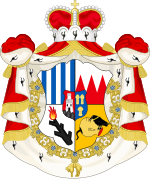
Arms of the princes of the senior branch
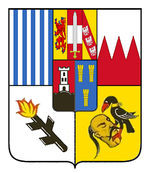
Arms of the princes of the Orlík branch

Orlík Castle
Princes of Schwarzenberg[]
- 1670–1683: Johann Adolf I
- 1683–1703: Ferdinand Wilhelm Eusebius
- 1703–1732: Adam II Franz Karl, Duke of Krumlov from 1723
- 1732–1782: Joseph I Adam
- 1782–1789: Johann I
|
Primogeniture (branch of Krumlov and Hluboká)
|
Secundogeniture (branch of Orlík)
|
In November of 1918, the Austro-Hungarian Empire ceased to exist.
Heads of the House of Schwarzenberg (after 1918)[]
|
Primogeniture
|
Secundogeniture
|
- 1979–present: Karl VII, son of Karl VI, adopted by Heinrich, thus unifying both lines
Title of the head of the Schwarzenberg family[]
| Styles of The Prince of Schwarzenberg | |
|---|---|
 | |
| Reference style | His Serene Highness |
| Spoken style | Your Serene Highness |
| Alternative style | Sir |
- H.S.H. The Prince of Schwarzenberg, Duke of Krumlov, Count of Sulz, Princely Landgrave of Klettgau (German: S.D. der Fürst von und zu Schwarzenberg, Herzog von Krummau, Graf von Sulz, gefürsteter Landgraf im Klettgau)
The other members of the Schwarzenberg family are not referred to as Dukes of Krumlov, and they should be addressed without the word "The" in front of their title of Prince or Princess. In the German language, the princely title of the head of the family is "Fürst", whereas other members of the family are titled as "Prinz" or "Prinzessin". The eldest son of the head of the family would be addressed with the title of "Erbprinz".
References[]
- ^ History of the Schwarzenberg family
- ^ History of the Schwarzenberg family
- ^ History of the Schwarzenberg family
- ^ History of the Schwarzenberg family
- ^ Heraldry of the House of Schwarzenberg
- ^ Heraldry of the Schwarzenbergs
- ^ The Schwarzenberg arms
- ^ Sugar, Peter F.; Hanák, Péter; Frank, Tibor, eds (1990). A History of Hungary. Bloomington: Indiana University Press. p. 97.
- ^ Slater, Stephen (2013). The Illustrated Book of Heraldry: An International History of Heraldry and Its Contemporary Uses. Wigston, Leicestershire: Lorenz Books. pp. 234,240-241. ISBN 978-0-7548-2659-0.
- ^ The Schwarzenberg Coat-of-arms
- ^ The Schwarzenbergs
- ^ History of the Schwarzenberg family
- ^ History of the Schwarzenberg family
- ^ History of the Schwarzenberg family
- ^ Heraldry of the House of Schwarzenberg
- ^ History of the Schwarzenberg family
- ^ Family tree of the House of Schwarzenberg
External links[]
| Wikisource has the text of a 1911 Encyclopædia Britannica article about Schwarzenberg. |
- Marek, Miroslav. "Family tree of the House of Schwarzenberg". Genealogy.EU. http://genealogy.euweb.cz/schwarzb/schwarzb1.html#E1.
- Family history and pictorial family tree
- The Schwarzenberg coat of arms
- Heraldry of the House of Schwarzenberg
- Description of the arms of the Princes of Schwarzenberg (Orlik branch) (in German)
- Almanach de Gotha info on the House of Schwarzenberg
| ||||||||||||||||
|
| This page uses content from the English language Wikipedia. The original content was at House of Schwarzenberg. The list of authors can be seen in the page history. As with this Familypedia wiki, the content of Wikipedia is available under the Creative Commons License. |


